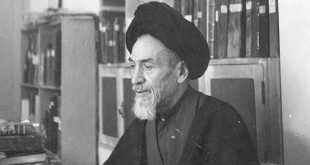4-2- The School of Traditionist Jurists
This school began at 4 A.H. and maintained a century. Leaders of this school are the most famous traditionist and jurists of Twelver Shi’a. Nearly all of them were living in the two most important religious and cultural cities of the time, Qum and Ray. They tried hard to purify, expurgate, and compile Shi’a traditions. This school was the continuity of the school of narrators at the time of (Imams’) presence. They mad an effort to collect traditions and save them. The followers of this school, usually, have no good relationship with ijtihād as mental activity based on a logical deduction.
Traditionist jurists, for following traditions, divided into two groups:
1- A group of them analyzed traditions using the science of Ḥadīth, and study of narrators. They were well informed of jurisprudential issues, and never accept any tradition without perusing attentively and checking its quality. They, though so briefly, were knowledgeable about the rules of jurisprudential principles in different states of reasoning, even, applied some of these reasoning that were addressed by Imams. Nevertheless, for adopting the traditional and conservative attitudes, they never tried to detach jurisprudence from traditions, and to write independent jurisprudential books. They were afraid to write jurisprudential matters except by the text of Ḥadīths. Their writings were a set of tradition’s textual contents classified in topical order, and, sometimes, the masters that a tradition was narrated from them were omitted. This group of jurists includes the traditionists like Muhammad b. Ya‘qūb Kulaynī (d. 329 A.H.), Muhammad b. Ali b. Bābwayh Qumī, known as Ṣadūq (d. 381 A.H.).
2- The other group of them was opposed to the rules of jurisprudential principles, uninformed about the rules and way of argument, and bigoted adherent of following the texts of Ḥadīths unconditionally. Some scholars of this group and their beliefs are mentioned in biographies, like Abū al-Husain al-Nāshī, Ali b. ‘Abdu Allah b. Waṣīf (d. 366 A.H.). His way was, reportedly, similar to the followers of formal religion. For the lack of logical arguments and independent reasoning (ijtīhād), and because there was no any new idea, their views failed to obtain a valuable position in jurisprudence field, and were ignored by jurisprudential textual sources.
At the latter parts of fourth century and the beginnings of fifth one, Sheikh Mufīd and his disciple, Sharīf Murtaḍā’s attempt overthrew the school of traditionist jurists. However, a few of its followers remained in some later periods, too. Nevertheless, it should be noted that this school, because of its long time hegemony over Shi’a scientific community, left great impressions on general Shi’a ideology, which never wiped out, and became the permanent parts of Shi’a ideology. Differences between Shi’a ideology at the time of Imams’ presence and letter eras, which appeared in some issues, origin from this effects.
Features of Traditionist Jurists
1- Changing the way of compiling traditions by:
a. compiling traditions in jurisprudential topical order,
b. Acquiring value of the chain of transmitters, and placing value on them. In addition, choosing a tradition that conveys certainty. In their point of view, two items identify this certainty: credibility of narrators, and being accepted by companions.
2- Issuing fatwas only by textual content of traditions: Nihāyah, written by Sheikh Ṭūsī, is the text of traditions. In addition, Sheikh Ṣadūq, at the beginning of his jurisprudential treatise, says: whatever I mentioned here is the textual content of authentic traditions.
 Ijtihad Network Being Wise and Faithful Muslim in the Contemporary World
Ijtihad Network Being Wise and Faithful Muslim in the Contemporary World
